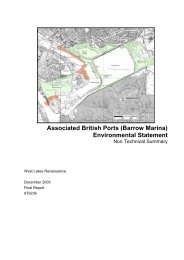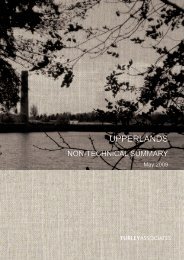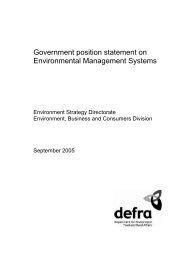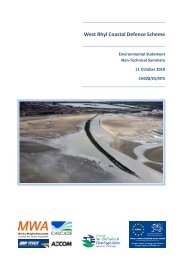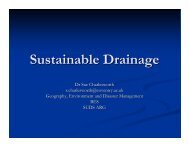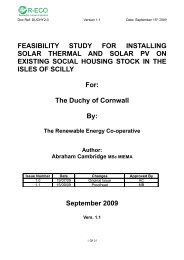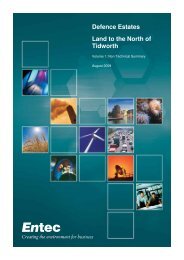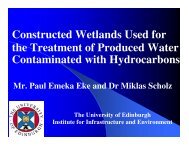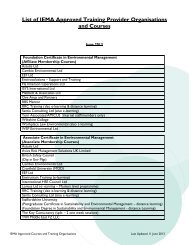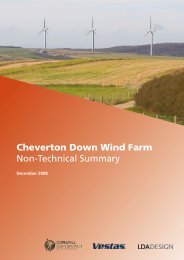Environment Law Bulletin - Institute of Environmental Management ...
Environment Law Bulletin - Institute of Environmental Management ...
Environment Law Bulletin - Institute of Environmental Management ...
You also want an ePaper? Increase the reach of your titles
YUMPU automatically turns print PDFs into web optimized ePapers that Google loves.
<strong>Environment</strong> Protection Act 1985 had led toit losing the pr<strong>of</strong>it it would otherwise havemade from processing the shellfish and thatthis sum was recoverable without pro<strong>of</strong> <strong>of</strong>default by virtue <strong>of</strong> section 153(1)(a) <strong>of</strong>schedule 4 to the 1995 Act. This sectionprovides that where oil has been dischargedor has escaped, the ship owner is liable for‘any damage caused in the territory <strong>of</strong> theUK by contamination resulting from thedischarge or escape’. Whilst the InternationalFund accepted the claimant’s loss <strong>of</strong> pr<strong>of</strong>ithad been foreseeable, it argued that thisflowed from the interruption <strong>of</strong> a businessrelationship with the primary victims <strong>of</strong> thecontamination. As a matter <strong>of</strong> law, such asecondary or relational claim was not recoverable.The High Court agreed and ruledthat the claim must fail for the same reasonsas those in Landcatch Ltd v The InternationalOil Pollution Compensation Fund [1999] 2Lloyd’s Rep 316, that is that it was an indirect,relational economic loss which was tooremote from the causal factor. The claimant’sappeal to the Court <strong>of</strong> Appeal was unsuccessful,that Court holding that the“This section provides that where oil has beendischarged or has escaped, the ship owner is liable for‘any damage caused in the territory <strong>of</strong> the UK bycontamination resulting from the discharge or escape’.”claimant’s action should be excludedbecause it was not engaged in any localactivity in the physical area <strong>of</strong> the contamination.Rather, its loss arose from its inabilityto process, pack and deliver the landed shellfishin a location far away from thepollution. This was a form <strong>of</strong> secondary lossand outside the intended scope <strong>of</strong> the 1995Act which was closely focused on physicalcontamination and its consequences. Incontrast, the local fishermen whose physicalactivities were closely affected by the oilpollution would be able to recover under the1995 Act as they had a direct economicinterest in the contaminated waters.(Alegrete Shipping Co Inc and Another v TheInternational Oil Pollution Compensation Fund 1971andOthers, [2003] EWCA Civ 65, 7 February 2003))AsbestosProceedings in negligence were broughtagainst the Royal Navy by Mr Matthews,a former electrical mechanic who claimedthat he had been injured by exposure toasbestos during his work on board shipbetween 1955 and 1968. In response,the Secretary <strong>of</strong> State certified undersection 10(1)(b) <strong>of</strong> the CrownProceedings Act 1947 that Mr Matthews’injuries would be treated as attributableto service for the purpose <strong>of</strong> an entitlementto an award under the NavalMilitary and Air Forces Etc. (Disablementand Death) Service Pensions Order 1983.The effect <strong>of</strong> this certificate was topreclude a claim in tort for personalinjury. The High Court held that section10 <strong>of</strong> the 1947 Act was a procedural barto a civil claim and was therefore incompatiblewith article 6(1) <strong>of</strong> the EuropeanConvention on Human Rights (“ECHR”)(the right to have the opportunity <strong>of</strong>having civil rights determined by an independentand impartial tribunal). Thisdecision was reversed by the Court <strong>of</strong>Appeal which allowed an appeal by theCrown and held that section 10 wassubstantive rather than procedural andthat article 6 <strong>of</strong> the ECHR did not apply.Mr Matthews’ appeal to the House <strong>of</strong>Lords was dismissed. Article 6 wasconcerned with procedural fairness andthe integrity <strong>of</strong> the state’s judicial system,not with the substantive content <strong>of</strong> itsnational law. Although defining theborderline between substance and procedurecould be difficult, the general nature<strong>of</strong> the distinction was clear in principle. Inthis case, section 10 <strong>of</strong> the 1947 Actsubstituted a no fault system <strong>of</strong> compensationfor a claim for damages, creating asubstantive limitation on the right to suethe Crown in tort under section 2, whichhad section 10 not been enacted, wouldotherwise have been available. The provision<strong>of</strong> a certificate by the Secretary <strong>of</strong>State did not alter this. It was not aprocedural limitation and so was notincompatible with article 6 <strong>of</strong> the ECHR.(Matthews v Ministry <strong>of</strong> Defence, [2003] UKHL 4,13 February 2003)<strong>Environment</strong> <strong>Law</strong> <strong>Bulletin</strong>April 200348



